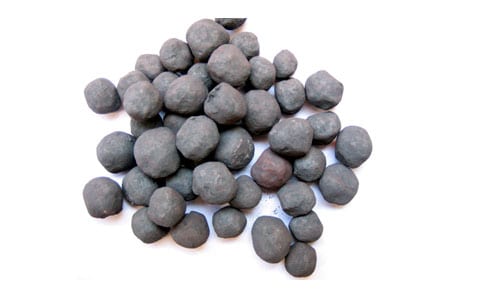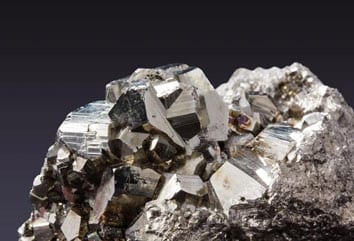Izberite jezik:
Iron ore is the fourth most common element in the earth’s crust. Iron is essential to steel manufacturing and, zato, an essential material for global economic development. Železo se pogosto uporablja tudi v gradbeništvu in proizvodnji vozil. Most iron ore resources are composed of metamorphosed banded iron formations (BIF), pri katerem se železo pogosto nahaja v obliki oksidov, hydroxides, in, to a lesser extent, carbonates.
The chemical composition of iron ores is apparent to be wide, especially for Fe content and associated gangue minerals. Major iron minerals associated with most iron ores are hematite, goethit, limonite, and magnetite. Glavna kontaminanta v železovih oazah sta SiO2 in Al2O3. The typical silica and alumina-bearing minerals present in iron ores are quartz, kaolinita, gibsit, diaspore, and corundum. Od teh, it is often observed that quartz is the main silica-bearing mineral, and kaolinite and gibbsite are the two main alumina-bearing minerals.


Iron ore extraction is mainly performed through open pit mining operations, privede do znatne proizvodnje. Sistem proizvodnje železne stene običajno vključuje tri faze: Rudarstvo, Predelavo, and pelletizing activities. Processing ensures that an adequate iron grade and chemistry are achieved prior to the pelletizing stage. Obdelava vključuje drobljenje, klasifikacija, Rezkanje, and concentration, with the aim of increasing the iron content while reducing the amount of gangue minerals. Each mineral deposit has its own unique characteristics with respect to iron and gangue-bearing minerals, and therefore, it requires a different concentration technique.
Magnetic separation is typically used in high-grade iron ore beneficiation, where the dominant iron minerals are ferro and paramagnetic. Magnetna ločitev z nizko intenzivnostjo (LIMS) techniques are used to process ores with strong magnetic properties, such as magnetite, while wet high-intensity magnetic separation is used to separate the Fe-bearing minerals with weak magnetic properties, such as hematite, from gangue minerals. Iron ores such as goethite and limonite are commonly found in tailings and do not separate very well by either technique.

Flotata se uporablja za zmanjšanje vsebnosti nečistoče v nizkih stopnjah železa. Železne orde se lahko koncentrirajo bodisi z neposredno anionsko flotacijo železovih oksidov bodisi z obratno kationsko flotacijo silicijevega; vendar, reverse cationic flotation remains the most popular flotation route used in the iron industry. The use of flotation is limited by the cost of reagents, the presence of silica and alumina-rich slimes, and the presence of carbonate minerals. Poleg tega, flotation requires wastewater treatment and the use of downstream dewatering for dry final applications.
The use of flotation for the concentration of iron also involves desliming, as floating in the presence of fines results in decreased efficiency and high reagent costs. Desliming je še posebej kritičen za odstranitev aluminija, saj je ločitev gibbita od hematita ali goetita s strani vseh površinsko aktivnih učinkovin precej težavna. Most alumina-bearing minerals occur in the finer size range (<20um), omogočanje njegove odstranitve z razganjanjem. Splošno, visoka koncentracija glob (<20um) in alumina poveča zahtevani kcationični zbiralni odmerek in dramatično zmanjša selektivnost. Zato, desliming increases flotation efficiency but results in a large volume of tailings and in loss of iron to the tailings stream.
Suha obdelava železne stene predstavlja priložnost za odpravo stroškov in proizvodnje mokroga repa, povezanih s flotacijo in mokro magnetno ločevanje vezja. STET has evaluated several iron ore tailings and run-of-mine ore samples at bench scale (lestvica pred izvedljivostjo). Opazili so pomembno gibanje železa in silikatov, primeri, ki so izpostavljeni v spodnji tabeli.

Rezultati te študije so pokazali, da je mogoče kazni za železo v nizkih razredih nadgraditi s triboelekrostatskim ločilom STET. Na podlagi izkušenj stet, proizvodov in/ali razreda znatno izboljšali pri obdelavi pilotne lestvice., v primerjavi s preskusno napravo na klopi, ki se uporablja med temi preskušanjih železne.
The STET dry electrostatic fine iron ore separation process offers many advantages over traditional wet processing methods, kot so magneti ali flotata, Vključno:
Contact us to learn more about dry processing of iron ore.
Reference:
Iron ore beneficiation involves a series of processes that aim to improve the purity and quality of raw iron ore. These processes include crushing, mletje, magnetno ločevanje, flotacijo, and gravity separation, depending on the mineralogical characteristics of the ore. Each technique is selected based on the ore’s composition and feasibility to extract the maximum amount of iron while minimizing impurities.
Iron ore mining requires specialized equipment to handle the extraction and processing of ore. Common machinery includes ball mills for grinding, crushers for reducing the size of ore, magnetic separators for separating iron particles from impurities, flotation machines for fine particle separation, and conveyors for transport.
Technologies utilized for iron ore beneficiation include advanced techniques such as dry electrostatic separation, flotacijo, advanced gravity separation, and sensor-based sorting. These technologies aim to efficiently increase the iron content and eliminate contaminants, catering to the growing demand for high-grade iron ore and promoting sustainable mining practices.
The cost of iron ore beneficiation can vary significantly depending on the specific processes and technologies used, the grade of the raw ore, and the desired purity of the final product. It encompasses capital expenditure (CAPEX), such as equipment and plant construction, and operational expenditure (Opex), including labor, Energije, in potrošnega materiala. It’s essential for companies to evaluate these costs against prospective revenue and market demands to ensure project viability.